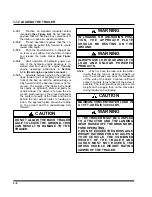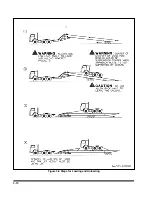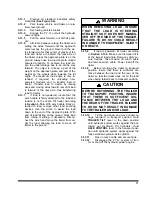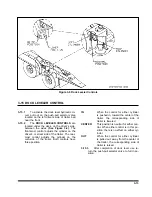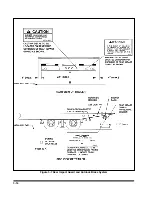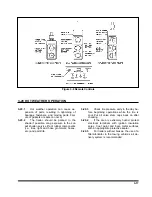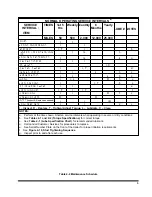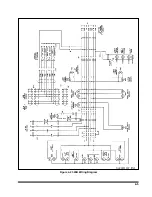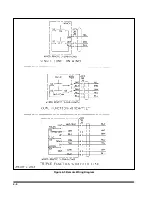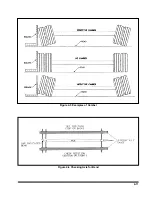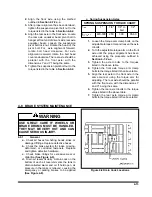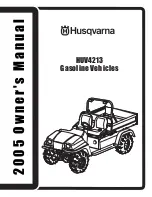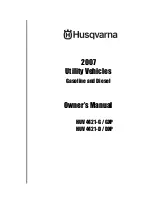
CAUTION
THE AUXILIARY (BLUE) CIRCUIT IS
FOR POWERING THE SEMITRAILER
ABS. THIS CIRCUIT MUST BE HOT
WHEN THE TRACTOR KEY SWITCH IS
ON. NO OTHER ELECTRICAL DEVICES
MAY BE POWERED BY THIS CIRCUIT
WHILE THE SEMITRAILER IS MOVING
FORWARD.
Malfunction in the ABS is signaled by illumina-
tion of the ABS warning lamp located at the left
rear side of the semitrailer. The warning lamp will
come on and stay on while power is supplied to
the ABS on a moving vehicle, if there is a fault. If a
fault in the ABS exists, normal braking will still oc-
cur, but wheels may lock. The semitrailer is still op-
erable, but the system should be serviced as soon
as possible.
CAUTION
IF A FAULT EXISTS IN THE SEMI-
TRAILER ABS, NORMAL BRAKING
WILL OCCUR, BUT WHEELS MAY
LOCK. SERVICE THE ABS AS SOON
AS POSSIBLE.
The ABS is also equipped with a Blink Code
Diagnostic Tool mounted at the right rear corner of
the undercarriage or at the very rear of the trailer.
This tool is used to identify faults that may occur in
the ABS so that they may be repaired.
Refer to ABS maintenance manual supplied
with trailer to answer basic questions for the anti-
lock brake system, obtain outline procedures on
how to adjust, test, remove, and install ABS com-
ponents, as well as how to test for faults in the
system by using “Blink Code Diagnostics”; and il-
lustrates ABS components, wiring, and plumbing
installation diagrams.
3-18 REMOTE OPERATION
3-18.1
The wired remote control plugs into an
electrical receptacle usually located by the
Hydraulic Control Panel. Optional receptacle
locations are on the rear street side or both
rear street and rear curb sides. The wired re-
mote is available as a single, dual, or triple
function.
(See Figure 3-8).
3-18.2
A wireless radio remote control is also
available as a dual, or triple function.
3-18.3
The remotes operate any of the hydrau-
lic functions that are desired. The remote
components are connected to the hydraulic
valve section that the remote is desired to
operate. The electrical switches operate the
functions of the hydraulic spool valve instead
of operating the control levers on the valve.
3-19 COLD WEATHER OPERATION
3-19.1
Cold weather causes lubricants to con-
geal, insulation and rubber parts to become
hard, which may lead to problems found in
bearings, electrical systems, and air systems.
Moisture attracted by warm parts can con-
dense, collect and freeze to immobilize
equipment. The truck/trailer operator must al-
ways be alert for indicators of cold weather
malfunctions.
3-19.2
During any extended stop period, nei-
ther the service nor parking brake should be
used as they can freeze up. Use wheel
chocks to secure the vehicle from moving.
3-19.3
Check all structural fasteners, air sys-
tem fittings, gaskets, seals and bearings for
looseness that can develop due to contrac-
tion with cold. Do not over-tighten.
3-19.4
Check tire inflation. Tire inflation de-
creases when the temperature decreases.
3-19.5
Periodically check drain holes in the bot-
tom of the relay valve (for trailers with air
brakes) and storage compartments. They must
be open at all times to avoid moisture en-
trapment.
3-16
Summary of Contents for 345B
Page 3: ...MODEL 345B TRAILER OPERATOR S MANUAL PURCHASED FROM DATE ADDRESS PHONE NO SERIAL NO ...
Page 8: ......
Page 12: ......
Page 22: ...3 10 Figure 3 4 Steps for Loading and Unloading ...
Page 26: ...3 14 Figure 3 7 Rear Impact Guard and Antilock Brake System ...
Page 30: ......
Page 35: ...4 5 Figure 4 2 345B Wiring Diagram ...
Page 36: ...4 6 Figure 4 3 Remote Wiring Diagram ...
Page 41: ...4 11 Figure 4 5 Examples of Camber Figure 4 6 Checking Axle for Bend ...
Page 46: ...4 16 Figure 4 10 Axle and Brake Assembly ...
Page 50: ...4 20 Figure 4 13 Outboard Mount Hub and Drum Figure 4 14 Inboard Mount Hub and Drum ...
Page 54: ...4 24 Figure 4 18 Mounting Tires and Wheels Figure 4 19 Stud Tightening Sequence ...
Page 65: ...5 9 NOTES ...







